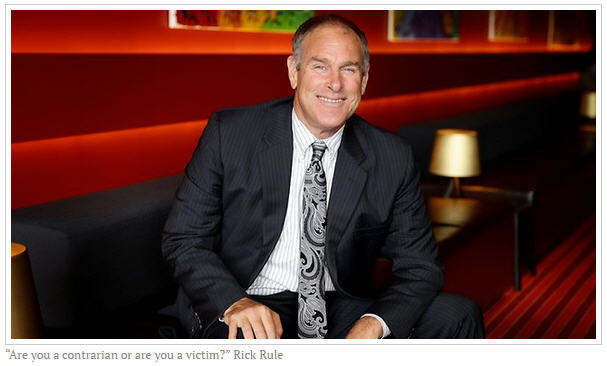Famed mining speculator Rick Rule on takeovers, technology and politics
Today we are talking about liberty, social media and the securities business with Rick Rule, the best communicator in the mining investment business, and the chairman of Sprott USA, the world’s leading natural resources and precious metals investor.
Mr. Rule has his own agenda for our call: he wants to remind the market of Sprott’spending offer to absorb Central GoldTrust and Silver Bullion Trust units on a NAV to NAV basis, which he says is in the best interest of unitholders. The Central Fund products have historically traded at a double-digit discount to NAV (up to 12% according to Rule), compared to almost no discount with Sprott’s Physical Gold Trust and Sprott Physical Silver Trust products.The Sprott products trade better because they offer some physical redemption features, and Sprott is a more transparent sponsor, being publicly traded. Rule tells me Sprott founder Eric Sprott was a former Central GoldTrust unitholder, and decided to launch Sprott’s physical products to address its shortcomings. “It’s time for the more investor-friendly product to eliminate the less investor-friendly product,” Mr. Rule says by phone from his Carlsbad, California office.
Sprott will pick up close to $1 billion in assets under management and tens of thousands of new customers assuming they’re successful in taking over the two bullion products.
“We would love to welcome those investors into the Sprott family so that they can enjoy a better product,” Rule said. He continues, “They will certainly think well of Sprott when their double digit discount evaporates and they begin to trade at par, and hopefully that good feeling toward Sprott will continue as the natural resource market improves and they will think about utilizing Sprott as investment managers for other natural resource and precious metal products that we offer.”
While I’ve got his attention, I want to grab more of Mr. Rule’s experiences for CEO.CA readers than just the company takeover line.
Rule tells me about his first foray into the investment business. He was working as a nightclub and restaurant owner/bouncer in Vancouver at age 19 to put himself through university (UBC). At the time, Rule wanted to be a tax lawyer, so he took the most prominent tax lawyer in Vancouver for lunch. The veteran told Rule he’d make a great rainmaker but a terrible lawyer, and so he introduced him to Canadian value investing icon Peter Cundill. Mr. Cundill taught a very green Mr. Rule about the basics of investing, and gave him copies of Intelligent Investor and Security Analysis, and even let Rule shadow him in his office for a few months. The mentorship “literally changed my life,” Rule says.
At the time, Cundill was an expert at analyzing very old and established holding companies, often with a mishmash of difficult to track securities and real estate, which the market was sometimes providing very little value for.
“If your entry is good, your exit takes care of itself,” Rule chuckled, adding that Cundill was not an activist investor, but knew how to communicate to the market the opportunities he saw in the investments he made.
I ask Rule about news in the investment newsletter world. We’ve heard reports that Stansberry and Associates acquired Casey Research yesterday, and Mr. Rule confirms (he is a friend and partner of both Porter Stansberry and Doug Casey). Mr. Casey is holding on to his shares and will stay with the new company, while Olivier Garrett, David Galland and Marin Katusa are moving on. Rule is confident Casey Research will be more successful than ever partnered with Stansberry.
Of the early-stage natural resource equities that Mr. Rule earned his fortune and reputation speculating in, he is optimistic.
“There is zero doubt that companies that are beginning to perform are catching bids. If you look at the turnover of the entire share float of Mariana Resources as an example, the better juniors are catching bids. If you look at the success that decent management teams have of raising money. The success that both Robert Friedland and Bob Quartermain have had attracting capital from Zijin Mining, one of the most sophisticated mining investors in the world, for their projects. The success that the Oxygen Capital Group have had, the success that Lukas Lundin has had with Lundin Gold. The truth is that for the best companies and the best teams, the bear market is over … all this tells you is that we reached a point in time with regards to the best companies where it’s the sellers, not the buyers who are capitulating. This is the same circumstance we reached in July of 2000.”
Rule’s now talking about the time he shared his devout anarcho-capitalist beliefs with well-meaning government employees. He asked the employees if they felt taxes were slavery or extortion, noting that since the government doesn’t buy and sell its citizens, taxes are more like extortion, than true slavery, taking 35-50% of our labours. Rule calls himself a coward for not being willing to face incarceration or death for opposing taxes. Instead he pays them on time and in full, with a smile on his face.
The government employees asked Rule how a society without government would provide roads, police and for the poor.
“Libertarians don’t compete with perfection,” Rule said. “They compete with what is. A much more simple test”
He then pointed to Disneyland and Disney World as two examples of privately run cities with exceptional cleanliness, little crime and satisfied citizens.
“When citizens are treated like customers, not chattel, there is customer satisfaction,” Rule says.
Rule’s also helping to fund a libertarian social media community called Liberty.me, and having joined up a few days ago I can confirm Mr. Rule is quite active on the site. If getting direct access to one of the world’s top fund managers is not reason enough to join Liberty.me, the service is only $5 a month (register here).
There’s another interesting topic that comes up during our call: conflicts of interest in the investment business. Sprott invests a fortune in research and generating investment ideas but does not publish those ideas, instead hoarding them for internal funds and clients. “Too often investment banking is influencing sell-side research anyway,” Mr. Rule adds.
There is no investment banking division at Sprott either: they’re adamant about working for investors, not for the issuers.
I let Mr. Rule have the final word:
“One of the important things to note about Sprott, is here we are at the bottom of the cycle with 360 million dollars in working capital, no debt, cash-flow positive and a market share relative to our competitors that has greatly, greatly expanded. If ever there was an organization ready for a rebound in the market, it’s Sprott.”
“What we would really ask people to do is to tender their Central Fund units for Sprott units in an upcoming offering circular which they will see. Certainly at the very least, we ask Central Fund holders to decide for themselves whether they would like to trade at a double-digit discount to par or at par and whether they would prefer to have their funds managed by a transparent public company.”
Thanks to Mr. Rule for his participation in this interview, and please visitwww.Sprott.com for more information.
More News
{{ commodity.name }}
{{ post.title }}
{{ post.date }}





Comments